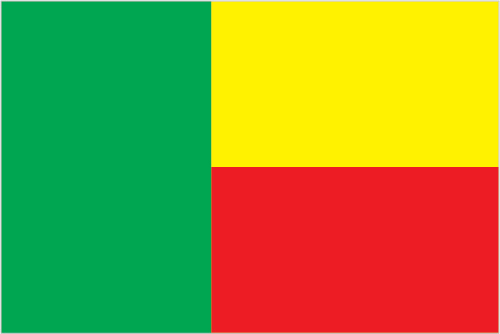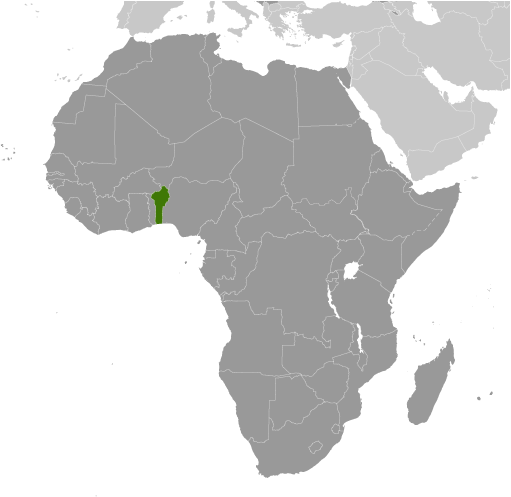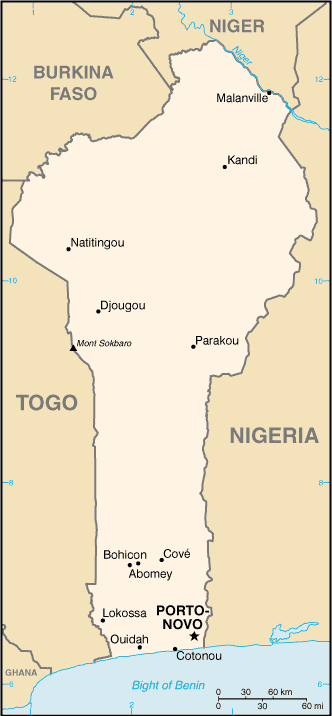|
Economy - overview:
|

|
|
The economy of Benin remains underdeveloped and dependent on subsistence agriculture, cotton production, and regional trade. Growth in real output had averaged almost 4% before the global recession and it has returned to roughly that level in 2011-12. Inflation has subsided over the past several years. In order to raise growth, Benin plans to attract more foreign investment, place more emphasis on tourism, facilitate the development of new food processing systems and agricultural products, and encourage new information and communication technology. Specific projects to improve the business climate by reforms to the land tenure system, the commercial justice system, and the financial sector were included in Benin's $307 million Millennium Challenge Account grant signed in February 2006. The 2001 privatization policy continues in telecommunications, water, electricity, and agriculture. The Paris Club and bilateral creditors have eased the external debt situation with Benin benefiting from a G-8 debt reduction announced in July 2005, while pressing for more rapid structural reforms. An insufficient electrical supply continues to adversely affect Benin's economic growth though the government recently has taken steps to increase domestic power production. Private foreign direct investment is small, and foreign aid accounts for the majority of investment in infrastructure projects. Cotton, a key export, suffered from flooding in 2010-11, but high prices supported export earnings. The government agreed to a 25% increase in civil servant salaries in 2011, following a series of strikes, increasing pressure on the national budget. Benin has appealed for international assistance to mitigate piracy against commercial shipping in its territory.
|
|
|
GDP (purchasing power parity):
|

|
|
$15.51 billion (2012 est.)
country comparison to the world: 139
$14.98 billion (2011 est.)
$14.47 billion (2010 est.)
note:
data are in 2012 US dollars
|
|
|
GDP (official exchange rate):
|

|
|
$7.541 billion (2012 est.)
|
|
|
GDP - real growth rate:
|

|
|
3.5% (2012 est.)
country comparison to the world: 97
3.5% (2011 est.)
2.6% (2010 est.)
|
|
|
GDP - per capita (PPP):
|

|
|
$1,700 (2012 est.)
country comparison to the world: 201
$1,600 (2011 est.)
$1,600 (2010 est.)
note:
data are in 2012 US dollars
|
|
|
GDP - composition by sector:
|

|
|
agriculture: 35.9%
industry:
6.4%
services:
57.7% (2012 est.)
|
|
|
Labor force:
|

|
|
3.662 million (2007 est.)
country comparison to the world: 96
|
|
|
Unemployment rate:
|

|
|
NA%
|
|
|
Population below poverty line:
|

|
|
37.4% (2007 est.)
|
|
|
Household income or consumption by percentage share:
|

|
|
lowest 10%: 3.1%
highest 10%:
29% (2003)
|
|
|
Distribution of family income - Gini index:
|

|
|
36.5 (2003)
country comparison to the world: 83
|
|
|
Investment (gross fixed):
|

|
|
22.6% of GDP (2012 est.)
country comparison to the world: 67
|
|
|
Budget:
|

|
|
revenues: $1.403 billion
expenditures:
$1.683 billion (2012 est.)
|
|
|
Taxes and other revenues:
|

|
|
18.6% of GDP (2012 est.)
country comparison to the world: 172
|
|
|
Budget surplus (+) or deficit (-):
|

|
|
-3.7% of GDP (2012 est.)
country comparison to the world: 126
|
|
|
Public debt:
|

|
|
30.2% of GDP (2012 est.)
country comparison to the world: 113
31.3% of GDP (2011 est.)
|
|
|
Inflation rate (consumer prices):
|

|
|
6.5% (2012 est.)
country comparison to the world: 172
2.7% (2011 est.)
|
|
|
Central bank discount rate:
|

|
|
4.25% (31 December 2010 est.)
country comparison to the world: 86
4.25% (31 December 2009 est.)
|
|
|
Commercial bank prime lending rate:
|

|
|
NA%
|
|
|
Stock of narrow money:
|

|
|
$1.836 billion (31 December 2012 est.)
country comparison to the world: 129
$1.715 billion (31 December 2011 est.)
|
|
|
Stock of broad money:
|

|
|
$2.95 billion (31 December 2012 est.)
country comparison to the world: 145
$2.716 billion (31 December 2011 est.)
|
|
|
Stock of domestic credit:
|

|
|
$1.602 billion (31 December 2012 est.)
country comparison to the world: 142
$1.475 billion (31 December 2011 est.)
|
|
|
Market value of publicly traded shares:
|

|
|
$NA
|
|
|
Agriculture - products:
|

|
|
cotton, corn, cassava (manioc), yams, beans, palm oil, peanuts, cashews; livestock
|
|
|
Industries:
|

|
|
textiles, food processing, construction materials, cement
|
|
|
Industrial production growth rate:
|

|
|
3% (2010 est.)
country comparison to the world: 93
|
|
|
Current account balance:
|

|
|
-$625.3 million (2012 est.)
country comparison to the world: 101
-$699.9 million (2011 est.)
|
|
|
Exports:
|

|
|
$1.578 billion (2012 est.)
country comparison to the world: 148
$1.593 billion (2011 est.)
|
|
|
Exports - commodities:
|

|
|
cotton, cashews, shea butter, textiles, palm products, seafood
|
|
|
Exports - partners:
|

|
|
India 32.4%, China 20%, Indonesia 6.8%, Niger 4.8%, Singapore 4.4%, Nigeria 4.2% (2011)
|
|
|
Imports:
|

|
|
$2.136 billion (2012 est.)
country comparison to the world: 162
$2.188 billion (2011 est.)
|
|
|
Imports - commodities:
|

|
|
foodstuffs, capital goods, petroleum products
|
|
|
Imports - partners:
|

|
|
China 31.1%, France 12.2%, UK 7.6%, US 6.7%, India 6.5%, Netherlands 4.6%, Belgium 4.3% (2011)
|
|
|
Reserves of foreign exchange and gold:
|

|
|
$977 million (31 December 2012 est.)
country comparison to the world: 139
$887.4 million (31 December 2011 est.)
|
|
|
Debt - external:
|

|
|
$953.5 million (31 December 2012 est.)
country comparison to the world: 158
$913.8 million (31 December 2011 est.)
|
|
|
Exchange rates:
|

|
|
Communaute Financiere Africaine francs (XOF) per US dollar -
514.1 (2012 est.)
471.87 (2011 est.)
495.28 (2010 est.)
472.19 (2009)
447.81 (2008)
|
|
|
Fiscal year:
|

|
|
calendar year
|
|
|
|





 )
)



